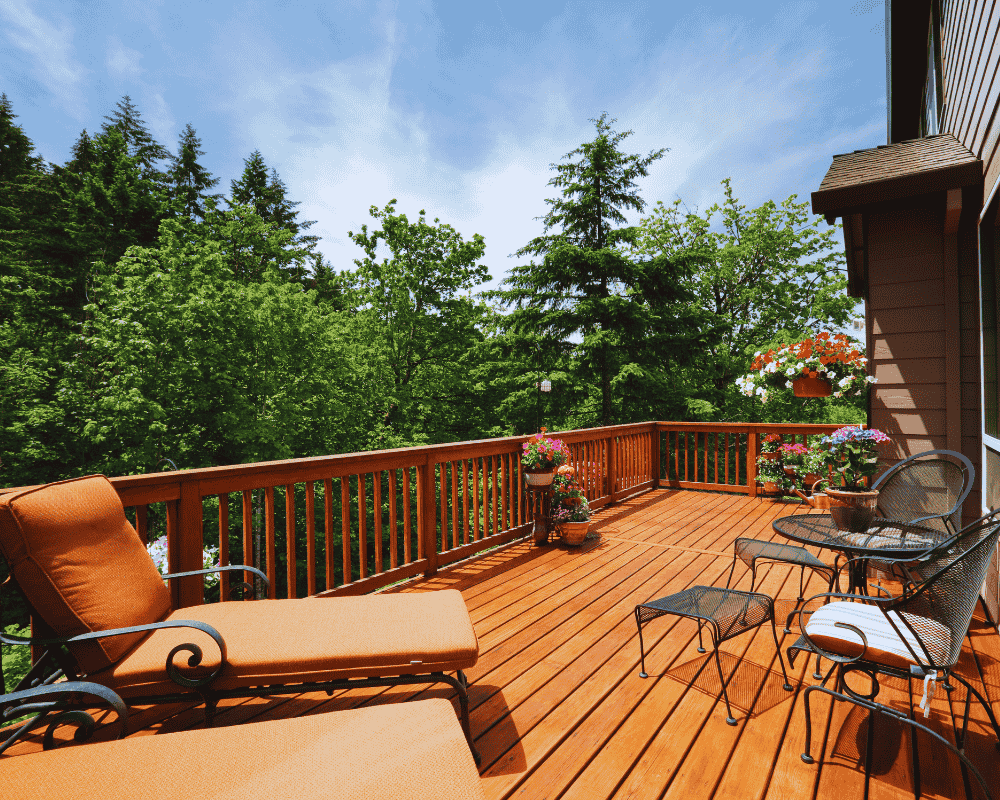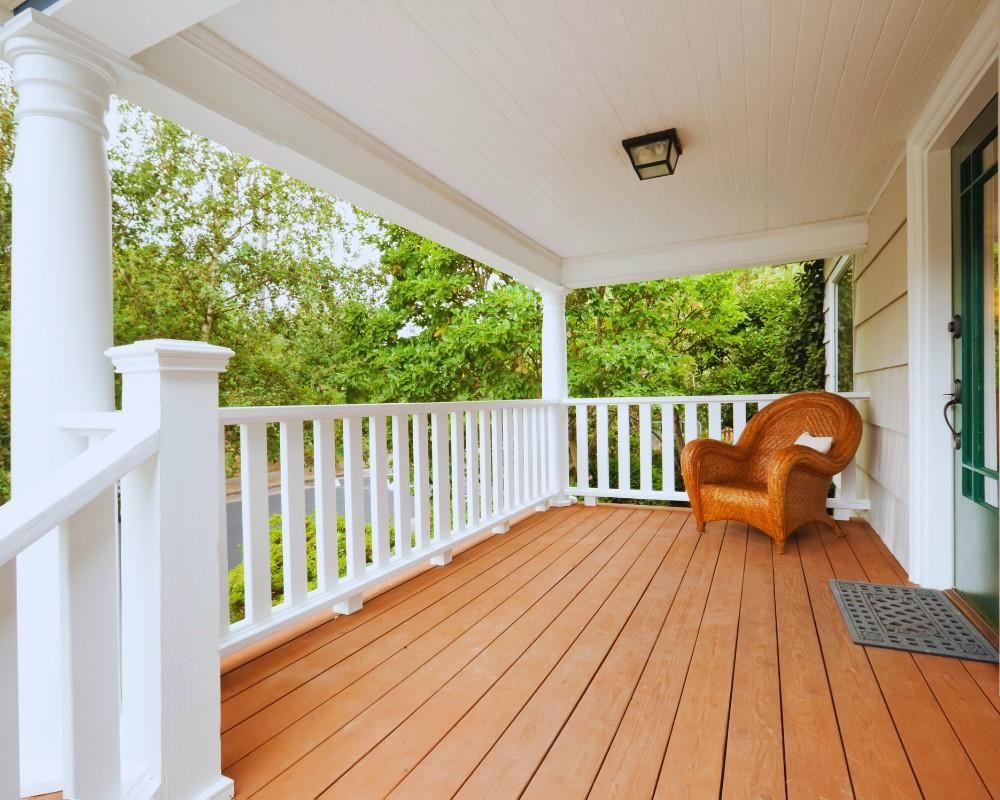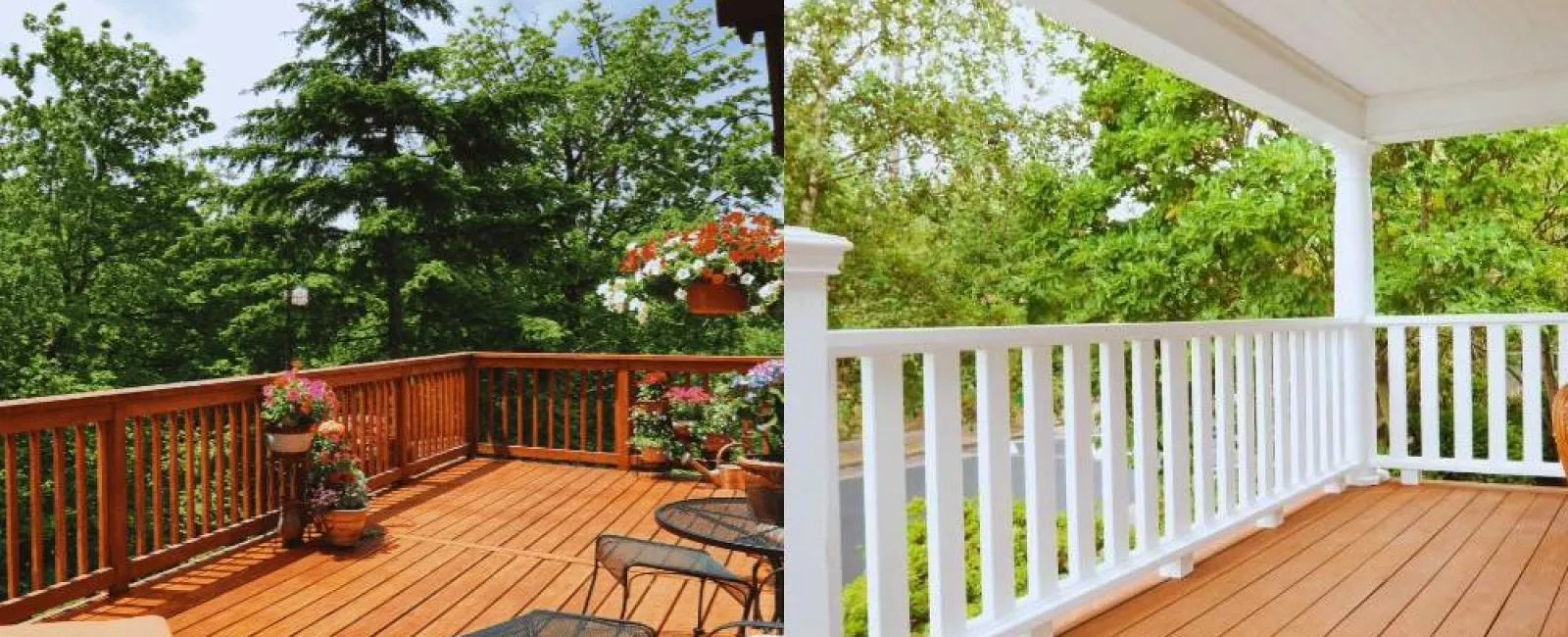The main difference between a deck and a porch is that a porch is a covered outdoor space, usually attached to the front or side of a home, while a deck is an open, elevated platform without a roof. Porches provide protection from the weather and often connect directly to an entryway, making them usable year-round. Decks are designed to create an outdoor living space for leisure and gatherings, typically located in the backyard, and offer unobstructed views of the outdoors.
Understanding the difference between a porch and a deck helps homeowners in Cumming make the best decision for their home's style, function, and long-term value. Both porches and decks add beauty and usability to a property, but they serve different purposes, have distinct designs, and require different types of maintenance. Choosing between them starts with understanding what each actually is.
Knowing the difference between a porch and deck can also impact how your space is used seasonally, how it complements your home's architecture, and even how it affects resale value. While both are popular throughout North Atlanta, the right choice comes down to whether you want an open outdoor space for relaxing and entertaining or a sheltered area that feels like an extension of your home.
What Is a Deck?
A deck is typically an open, elevated platform built from wood or composite materials. Unlike a porch, it does not usually have a roof or full enclosure, though it can be partially covered with pergolas or awnings. Decks are designed to maximize outdoor views and provide an open-air environment that blends seamlessly with the surrounding landscape.
Decks are often located in the backyard, making them perfect for entertaining, barbecuing, or creating a relaxing space to enjoy nature. A front deck is less common but can be a good design choice for modern or rustic-style homes. Decks can be built at ground level, slightly raised, or multiple stories high, depending on the home's layout and the terrain.
Because decks are exposed to the weather, they require regular maintenance, including sealing, staining, or cleaning to protect against moisture, UV damage, and wear. Composite materials can reduce maintenance needs but still require periodic upkeep to maintain their appearance and durability.

What Is a Porch?
A porch is a covered outdoor space that is typically attached to the front, side, or back of a house. When asking what is considered a porch, the key elements are its roof structure and connection to the home's entrance. Porches are often designed to provide shelter from rain, sun, and wind, making them more usable throughout the year compared to an open deck.
Porch designs can range from open-air with railings to partially enclosed with screens or glass. In traditional Southern architecture, a porch is a welcoming transition space between the indoors and outdoors, often furnished with seating, plants, and décor. Unlike a deck, a porch's roof is an integral part of its design, offering shade and protection for furniture and guests.
Front porches serve as a focal point for curb appeal, providing a charming and functional entryway. Back porches are often used as cozy outdoor lounges or dining areas, especially when screened in to keep insects away

Deck vs Porch: The Key Differences
While both porches and decks add value and enhance outdoor living, the decision between a deck and a porch comes down to key differences in structure, placement, and function.
1. Roof and Enclosure: The most significant difference between a porch and a deck is the presence of a roof. Porches are covered, offering protection from the elements, while decks are generally open to the sky.
2. Location: A porch is typically at the front or side of the home and connects directly to an entrance. Decks are more often located in the backyard, providing a private space.
3. Purpose: Decks are designed for open-air enjoyment, ideal for sunbathing, dining, or entertaining. Porches are better for sheltered seating, year-round use, and creating a welcoming entrance.
4. Materials: Decks are often built from pressure-treated wood, hardwoods, or composite materials. Porches can use similar materials for flooring, but incorporate structural supports for a roof and sometimes screened walls.
5. Maintenance: Decks require regular upkeep due to exposure, while porches have some protection from the roof, reducing weathering on flooring and furniture.
Choosing Between Porches and Decks for Your Home
Deciding between porches and decks depends on your lifestyle, climate, and design preferences. If you love the idea of relaxing outdoors regardless of the weather, a porch offers versatility and protection. If you prefer an open space that blends into your yard, a deck provides unobstructed views and a more natural connection to the outdoors.
Design Considerations for a Porch
When considering what a porch brings to your home, think about how it complements your architecture. A porch should complement your home's style, from the slope of the roof to the details of the railings.
Adding features like ceiling fans, lighting, and comfortable seating can make your porch an inviting space. Screened porches are popular in areas with a high insect population, and glass-enclosed porches can function almost like a sunroom, extending usability into cooler months.
The flooring material for a porch should withstand outdoor conditions but also provide comfort underfoot. Wood, composite decking, or even concrete with decorative finishes can work well.
Design Considerations for a Deck
When planning a front deck or backyard deck, think about the overall flow of your outdoor space. Decks can be multi-level, wrap around a pool, or connect with garden areas. Railings and steps should match the home's design and meet safety requirements.
For a low-maintenance option, composite decking offers durability and resistance to rot, insects, and fading. Natural wood provides a classic look but requires more upkeep. Built-in seating, planters, and lighting can make a deck both functional and visually appealing.
Orientation is an important factor as well. A south-facing deck will get more sunlight, which is great for warmth but may require shade solutions. A north-facing deck will be cooler but may stay damp longer after rain.
Long-Term Value of Decks and Porches
From a resale perspective, both decks and porches can boost home value. Buyers often see these spaces as bonus living areas that enhance lifestyle appeal. However, the type of space that offers the most value depends on regional preferences and the home's style.
In neighborhoods where a porch is a common architectural feature, adding or upgrading one can significantly improve curb appeal. In areas where outdoor entertaining is a priority, a large, well-designed deck can be a major selling point.
Maintenance plays a role in long-term value as well. A well-kept deck or porch signals that the home has been cared for, which can make a positive impression during a sale.
Summary
When comparing a deck vs a porch, the main distinction is that porches are covered and more connected to the home's entry, while decks are open platforms designed for outdoor leisure. Deciding between the two comes down to how you plan to use the space, your climate, and your budget.
Porches excel in providing year-round usability and a welcoming focal point, while decks maximize open-air enjoyment and flexibility in placement. Both can be customized to reflect your style, enhance your property, and create a lasting outdoor retreat.
Transform Your Outdoor Living Space with Forsyth Exteriors
At Forsyth Exteriors, we specialize in designing and building both porches and decks that elevate your home's comfort and style. Whether you're envisioning a cozy covered porch for morning coffee or a deck for weekend gatherings, our team will help you choose the right option based on your lifestyle, home architecture, and long-term goals.
Contact us today to start planning your perfect outdoor space.


